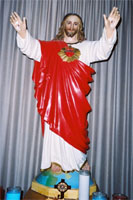
 |
GUIDELINES FOR ALTAR SERVERS I. Introduction II. Selection III. Formation IV. Commissioning V. Clothing VI. Responsibilities VII. Procedures at the Celebration of the Eucharist VIII. Resources for Preparing Altar Servers
In accord with the 2003 General Instruction of the Roman Missal, the following guidelines for altar servers are promulgated for the Diocese of Owensboro, Kentucky. I. INTRODUCTION Since the second century, servers have always had a place in the Eucharistic Celebration. Surely from the very beginning of the Celebration of the Breaking of Bread there were those who prepared for the celebration, assisted at the table and put things back in order afterwards. Servers are a very ancient tradition in the liturgical experience of the church. In the history of the Church, altar servers were young men who were studying to be priests. That is why the Church said at that time that only boys could be servers, because only men could be priests. Today, it is no longer true that a server needs to be studying to be a priest. It is still true that only men can be priests, but the ministry of server is no longer limited to males only. It is now allowable and encouraged that girls and women serve in this ministry as well -- as they do in all other lay liturgical ministries. II. SELECTION The server is a member of the assembly who assists the priest during the Eucharist and other liturgical ceremonies so that the liturgy can be conducted with grace and reverence. Servers should be active and full participants in the celebration with the understanding that they are first and foremost members of the assembly. The server expresses this by singing, praying and keeping silence along with the rest of the assembly. Ideally, servers are fully initiated Catholics. Altar servers must have received the Sacraments of Baptism and Eucharist; however, youths who have not been confirmed may act as servers. Servers normally receive the Eucharist whenever they participate in the liturgy. The minimum age and scheduling procedures are left to the pastorís discretion. Recommended minimum age for youth is about fifth grade. Servers are expected to be appropriately prepared, committed to giving their time and talent to their parish community, and willing to serve Godís people. They should be able to understand the Eucharistic celebration, the other sacred rites, and the liturgical function of this ministry. III. FORMATION As with other ministries, the ministry of server requires individuals to be trained so they can conduct themselves appropriately. The training needs to be adapted to the educational level of those who are participating but at a minimum should include exposure to the following areas: 1. Ministry to the Assembly a. A general introduction b. The meaning of service c. Types of ministries 2. The Eucharist -- overview of the Mass and its parts and their meaning 3. Names and descriptions of books, vessels, vestments, the seasons of the year and their importance, the vocabulary of liturgy. 4. Procedures -- the duties of the server at the celebration of the Mass. 5. Other liturgies -- morning and evening prayer, weddings, funerals, baptisms, confirmation, etc. IV. COMMISSIONING The Order for the Blessing of Altar Servers, Sacristans, Musicians, and Ushers (Book of Blessings, nos. 1847-1870) may be used before servers first begin to function in this ministry. V. CLOTHING Servers may wear the alb or other appropriate or dignified clothing. All servers should wear the same liturgical vesture. VI. RESPONSIBILITIES Servers carry the cross and the processional candles, hold the book for the priest celebrant when he is not at the altar, carry the incense and censor, present the bread, wine and water to the priest during the preparation of the gifts or assist him when he receives the gifts from the people, wash the hands of the priest, and assist the priest as necessary. In the absence of a sacristan, the servers may prepare the altar and sacred vessels before Mass. Since the role of server is integral to the normal celebration of the Mass, at least one server should assist the priest. On Sundays and other more important occasions, two or more servers should be employed to carry out the various functions normally entrusted to these ministers. Since the tasks of the server can vary depending upon local circumstances, it is important that the local pastor develop a ministry description for the Server so individuals who serve will be aware of their usual responsibilities to this particular assembly. VII. PROCEDURES AT THE CELEBRATION OF THE EUCHARIST Since procedures for Servers vary from parish to parish, each parish should develop their own ministry description for the ministry of Server. Such a description should include the following: a. Before the liturgy: What are the expectations and responsibilities for the Server when arriving for liturgy? What is the arrival time? (i.e. Setting out the cruets and the bowl and towel for washing of hands, place the needed books in the proper places in the Sanctuary, lighting the candles, etc.) b. During a liturgy: What is the role of the Server in the order of procession, the Introductory Rites, the Liturgy of the Word, the Liturgy of the Eucharist, and the Concluding Rites? c. Following a liturgy: What are the responsibilities for clean up in the sacristy and in the worship space? VIII. RESOURCES FOR PREPARING ALTAR SERVERS Serve God with Gladness: A Manual for Servers published by Liturgy Training Publications is an excellent workbook for training elementary age servers. The Ministry of Servers published by The Liturgical Press is also a helpful resource. A video entitled Training the Mass Server is also available from the same publisher.
|

